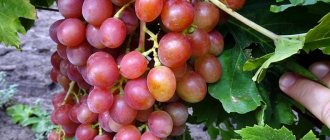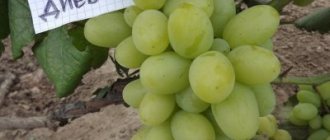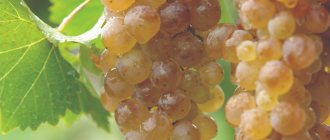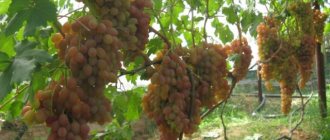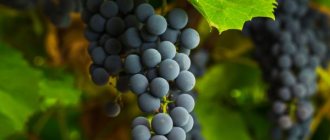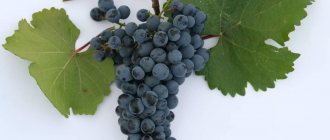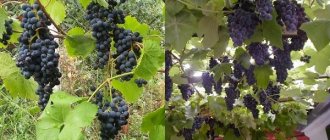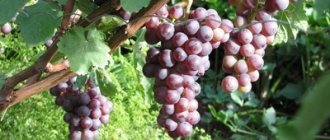Russian Concord grapes - winter-hardy grapes
Grapes Russian Concord - winter hardy grapes
CHARACTERISTICS OF THE VARIETY (from literary sources) Russian Concord grapes are a variety with large berries that grow in the Poltava region in uncovered cultivation and ripen 3 weeks earlier than the Lydia grape variety.
The Russian Concord grape belongs to the universal, isable, vigorous varieties of early-medium ripening period (125...140 days/2600-2800°C). The variety was bred in 1947 by crossing the Severny and Saperavi varieties.
The clusters are of medium size, medium density, cylindrical in shape, branched. The berries are large, round, dark red with a purple tint and covered with a layer of medium density pruin. The pulp is fleshy-juicy, slimy, with a strawberry flavor. The skin is medium thick. The Russian Concord grape harvest is used in its natural form.
The bunches store well, and when stored, the taste of the berries improves. Berries in the Donetsk region fully ripen in mid-September. In the conditions of Michurinsk, the period of vegetation and ripening of bunches from the beginning of bud break to the full ripeness of the berries is 128 days. In the region of Novocherkassk and Tsimlyansk, full ripeness of berries occurs in the third ten days of August and the first ten days of September, respectively.
Photo 1. Russian Concord grapes
The sugar content of the berries is high 15-18%, acidity 4-6 g/l. The shoots ripen well. The variety is high-yielding, 4-6 kg per bush or 70-80 c/ha.
The flower of the Russian Concord grape variety is functionally female, but is well pollinated by neighboring bushes, which can be the Lydia and Metallichesky grape varieties. Russian Concord is characterized by increased resistance to fungal diseases and frost. In terms of frost resistance, it surpasses all varieties of the European species (Vitis Vinifera), but is inferior to Korinka Michurina and Buitur.
It is widely used in the northern viticulture regions, where it is included in the standard assortment. It is grown in vineyards in the Rostov region, Krasnodar region, as well as in the Donbass and in small quantities by amateur winegrowers. Russian Concord berries are mainly used both in their natural form and for technical purposes.
OWN EXPERIENCE. The Russian Concord grape variety was the very first variety that I planted on my newly acquired plot, still knowing almost nothing about the grape plant. The cuttings were given by a familiar summer resident at the end of February. To the question. What sort of? The answer is good, the berry is dark red, sweet, and always ripens.
He grew up at his dacha in the village and at home in Poltava under the windows of a 5-story building in an unsheltered culture. The bush was large and reached right up to the 5th floor. Shaping - how it turns out, the dead wood was cut off in the spring and that’s it. I don’t know about the watering, but no one did any spraying and the bush didn’t get sick. On the last Sunday of February 1990.
I came to his house, we went out onto the balcony and in my presence he cut cuttings for me, and also told me how to grow grape seedlings from them in cups. I used this method (described in the article “Growing grape seedlings in paper cups”), since this was my first experience, and I did not know other methods of growing seedlings at that time.
On the site, I planted a grape seedling near the parking lot and formed it into a gazebo to create shade, and formed one sleeve as a horizontal cordon on a fence about 6 m long. For 20 years, the harvest always ripened. Depending on the weather, full ripeness of the berries occurred between September 1 and September 20.
I don’t know what their sugar content is, but they taste very sweet, one might even say sickly sweet. The productivity is very high. The berries are large, the clusters are small. From this one bush I pick 6-8 buckets of grapes. The bunches are preserved well both on the bush and in the cellar, laid out in boxes in one layer (it was possible to store until January).
Resistance to fungal diseases is average. So far there were 2 bushes of Isabella varieties on the site (this bush and a bush of Lydia grapes), and on the neighboring one at a distance of 10m across the road there was also a bush of some Isabela hybrid, there were no fungal diseases. When young seedlings of different grape varieties grew on the site, diseases appeared and 3-4 preventive sprayings were required to overcome them.
The Russian Concord grape variety was used mainly for fresh consumption, until the berries of table grape varieties such as Aleshenkin, White Rose, Vostorg, Kodryanka, Strashensky, Kesha-1 (Talisman), and Original appeared.
In addition to consuming fresh Russian Concord grapes, there have been attempts to make jam, compotes, pickle and make homemade wine. All this was gradually abandoned.
The jam from Russian Concord grapes, like from Lydia grapes, has a lot of seeds, but the taste is so-so. Jams, compotes and pickled grapes are more tasty from large-berry grape varieties such as Vostorg, Strashensky, Kesha-2. Particularly tasty pickled grapes can be made from the berries of the Strasensky grape variety - an excellent snack. And the compotes are delicious even with half-green Original grapes.
Homemade wine was made using the red method without adding sugar. Basically it turned out good, but slightly rich and I don’t like the isabelle taste. Kuderka wine grapes make it much tastier. Once it turned out well, maybe because after overflowing in January it carbonated itself and was somewhat reminiscent of champagne.
Two years ago, the bush was bred because they stopped consuming it fresh because of its isabella taste and slimy capshuk in the middle of the berries. Therefore, the harvest was mainly distributed to neighbors. In addition, the bush began to suffer from mildew and additional spraying was required, and the overgrown bushes of the Kuderka grape and the Pleschistik type began to give shade.
Photos of bunches of the Russian Concord grape variety and a bush growing on the fence can be seen in the photo gallery.
An unpretentious, vigorous, high-yielding, frost-resistant isabella variety of medium-early ripening with average resistance to fungal diseases, producing low-quality berries. Compared to the Isabel grape variety Lydia, the berries of Russian Concord ripen 3 weeks earlier in the conditions of the Poltava region.
Read more: Duck diseases: symptoms and treatment
FORUM GRAPES
Grapes, berry fields, planting, new varieties, fertilizers. Diseases and pests of grapes.
- Unanswered topics Active topics –>
- Search
- our team
Re: Russian Concord
Post by Oleg Gorbunov » 07 Feb 2015, 23:31
Exactly, not a Concorde. It doesn’t rot, doesn’t burst, and wasps don’t eat it.
Regards, Oleg.
Re: Russian Concord
Post by Vasilich 55 » 17 Sep 2015, 12:15
Russian Concorde. Harvest 2013
Harvest 2014
This year the Russian Concord opened its buds for the first time on May 20th. On August 9, 2015, it is clear that the arrows have entered the maturation phase
On September 15, the berries and arrows were fully ripe. You can safely put it away for the winter
Some statistics and comparisons. August and early September were cold. All grape varieties have put on the brakes on ripening. The Russian Concord took 115 days, Super-Extra and Elegant St. 110 days, Libya has lost acid as of today, the sugar is weak, the varietal taste is zero, but it is ready for Radiant.
Re: Russian Concord
Post by Yann » 17 Sep 2015, 14:15
Re: Russian Concord
Post by Vasilich 55 » Sep 18, 2015, 07:48
Re: Russian Concord
Post by Yann » Sep 18, 2015 10:49 am
Re: Russian Concord
Post by Grape » Sep 18, 2015, 11:36 am
It’s strange that it does NOT gain sugar. Russian Concord is distinguished by uneven ripening (and coloring) of the berries in the cluster, BUT. THIS is exactly what is very attractive, because... A freshly colored berry, even if there are 1-2 of them in a bunch and the rest are oak-oak, ALREADY completely loses acid and acquires the same taste and unique aroma as a fully ripened bunch.
The bunch fully ripens in my conditions (Kazan) by September 15-19 (when you can safely harvest), but we start “pecking” the berries from the beginning of September and no one can pass by (there are such dense green ears with red speckles). For clarification and comparison, such tasty varieties as Tason, Harold, Zagadka Sharova, Korinka Russkaya, and Guna are already ready or even harvested on the site by the beginning of September. but nevertheless, the Russian Concord comes in favorite and reliable varieties, regardless of the fall.
Apparently grapes are indeed a culture of place and time. well, it’s also re-sorted
Re: Russian Concord
Post by olga.kuteinikova » 08 Oct 2015, 16:11
The yield of the Russian Concord is good. This year I left at least 50 shoots per bush, without removing the inflorescences at all. It turned out that there were 2-3 bunches per shoot. The average weight of a bunch is 300 – 350 grams. It turns out that with a load of 2-3 bunches per shoot we get approximately 800-1000 grams. from the escape.
On 50 shoots approximately 50 kg. And this is quite decent, considering its main advantage - high frost resistance, which makes it possible to grow this grape variety in the northern regions. I can also say that another feature of the variety is that even with insufficient coloring (full technical ripeness), the berries are already quite tasty. Concord can hang on the bush for a long time, right up to the snow, without losing its appearance and taste, the taste even improves.
Story
The Russian Concord grape was bred on the basis of the variety of the same name in the USA. The new species owes its successful appearance to the American Concord and the Amur grape variety. The Concord variety, bred by Russian breeders, has become an excellent alternative to another common species, Lydia, due to its increased resistance to frost, various diseases and pests.
Important! This varietal grape is able to easily and without consequences tolerate frosts down to -30°C.
The Concord grape variety has an interesting biography. This is a spontaneous hybrid from the USA. In 1843, the variety was identified in the city of Concord in Massachusetts.
Thomas Bramwell Welch used this variety to produce the world's first pasteurized juice in 1869. He could doubt anything, but not the taste of the resulting product; until the middle of the last century, his son produced excellent marmalade.
In addition to juice and marmalade, sparkling and sweet kosher wines are made from Concord grapes. Separately, it is worth noting the Concord wine.
It retained all the charm of the taste and aroma of fresh berries. Old world winemakers call this deviation from the standards they invented a fox tone, but this is not important, what is important is that the wine is good.
In New York, Concord is the main table variety. Its dessert qualities are excellent, and it should be noted that it not only stores well, but when stored it only becomes tastier.
We can safely say that the Concord grape is a symbol of American viticulture. In 1999, an exhibition dedicated to the Concord grape variety was held under the title “Concord - America's Grape Classic.”
Grapes are a unique healer. Doctors paid attention to the anti-cancer effect of grapes a long time ago, but a lot of time passed before anti-carcinogenic substances were discovered. They contain 72 species of different plants, and grapes contain the most.
Grapes, their berries, skins, and seeds contain resveratrol. It was discovered in the nineties of the last century, but long before that, back in the century before last, Dr. Johanna Brand successfully treated stomach cancer with berries with peel and grains. She used a certain variety for treatment. This is the Concord grape variety.
The varieties Princess Olga, Beauty of the North and Delight Ideal have healing powers.
The variety originated from its American parent, the Concord species, which gave it life. It is recommended to take into account: the parent of the variety is a scientist-breeder who managed to cross two grape varieties and get one. The first variety was the already famous Concord, and the second was Amur grapes.
American Concord - the ancestor of the Russian variety
This discovery occurred a couple of years after the end of the Great Patriotic War, namely in 1947. It was from that time that grapes became widespread throughout the Soviet Union, and modern winegrowers also actively use this type of crop, planting it in their vineyards to get an excellent and rich harvest.
Amur grapes gave the variety high frost resistance
Botanical description
This variety is characterized by the following botanical features:
- The leaves are large, dense, with a weak dissection, three-lobed, rounded. The upper side of the leaf is matte bright green. The underside of the leaf is pubescent, has a light green tint, and the main veins are bare. The edges of the leaves are covered with low, wide teeth with sharp tips.
- The flower is functionally female, and therefore plants need pollinators.
- The brushes are small (10-13 centimeters in length), medium dense, branched, cylindrical or conical in shape. The mass of the brush reaches an average of 120 g. The berries are large, fleshy, juicy, round in shape, their color can be dark red with a purple tint or dark blue. The berries are densely covered with a waxy coating, they have a sweetish taste and a pleasant smell. The skin of the berries is dense.
The Concord grape variety is one of the table wine varieties, which is ideal for both eating and making wine. Most winegrowers and simply those people who love grapes and appreciate this berry note a taste and aroma that is completely unusual for such an unpretentious variety.
The Concord variety tastes nothing short of wonderful. Pleasant notes are felt even when eating fresh fruit, just torn from the bunch, which is quite large in size. The pulp is filled with a “foxy” aroma, which creates a special taste. After so much praise, it is important to note that eating the berries is not convenient, because the pulp is separated by a special “bag”, a skin that can be felt on the tongue and causes unpleasant sensations. The pleasant smell that floats in the air and the taste cannot be overshadowed by this is the only inconvenience associated with Concord grapes.
Concord grapes store well and do not lose their beneficial properties, and the taste of the berries even becomes more intense when stored
The species is used not only for use in food or making wine, although these areas of application can be called the main ones for this variety. Another area in which grapes are used is landscape design. Due to its rapid growth, the plant is used for:
- Decorating summer cottages.
- Houses
- Gazebo.
- Fontanov.
This creates a pleasant atmosphere, fills the area with greenery and a pleasant smell.
The leaves of the grapes are large in size, which cannot but please the owners of those areas where grapevines are already climbing. Flowers are represented by both sexes, and the shoots grow quickly and harmoniously, helping each other with the help of nature, which created them. The vine grows quickly, which can even somewhat surprise a winegrower even with extensive experience.
The rapid growth force allows you to achieve positive results not only in increasing the green vegetation around the house and in the garden, but also to please you with an excellent and rich harvest.
The berries of the Concord family of grapes are large in size, and in other respects they are similar to many other varieties. Thus, a round shape and a dark blue color are standard characteristics that are ideal to describe many grape varieties. The skin of this grape variety is distinguished by its density, thick, durable, the grapes remain susceptible to certain natural phenomena and weather conditions. The cluster of grapes can be medium-sized, but in the vast majority of descriptions it should be described as large and impressive.
Read more: How to preserve chrysanthemums in winter - All flowers
- The leaves are large, dense, with a weak dissection, three-lobed, rounded. The upper side of the leaf is matte bright green. The underside of the leaf is pubescent, has a light green tint, and the main veins are bare. The edges of the leaves are covered with low, wide teeth with sharp tips.
- The flower is functionally female, and therefore plants need pollinators.
- The brushes are small (10-13 centimeters in length), medium dense, branched, cylindrical or conical in shape. The mass of the brush reaches an average of 120 g. The berries are large, fleshy, juicy, round in shape, their color can be dark red with a purple tint or dark blue. The berries are densely covered with a waxy coating, they have a sweetish taste and a pleasant smell. The skin of the berries is dense.
Grapes Russian Early
The variety's grape clusters are highly branched and have medium density. The shape is cylindrical. The weight of one bunch can reach 1 kg, but despite this, Concord is well stored.
Many gardeners note increased yields. From 1 g of vineyard you can get up to 80 centners, and from a bush - 4-6 kg, which is very much compared to the same Lydia.
What grapes look like - Concord variety
The berries of this variety are fleshy and juicy, large round in shape, with a hint of strawberry in the taste. The skin is medium thick. The color changes during ripening from pink to dark red with a purple tint, and then to dark blue.
For your information! It is advisable to consume Concord grapes fresh, since during heat treatment they partially lose their taste, becoming less aromatic, so it is better to choose a different type for preservation.
Concord grapes are a table and wine variety. The berry is large or medium in size, round in shape, dark blue in color, collected in medium or large clusters. The skin is dense.
Wine varieties traditionally include Krasin, Tempranillo and Merlot.
The taste is simply wonderful. The aroma is reminiscent of the well-known Isabella variety, but both the taste and aroma contain notes of wild berries and black currants, which makes it more refined.
The Concord grape variety has a bush of great growth vigor; it is characterized by a vine-like type of vine, which makes it possible to create arched plantings.
Rosalind, Anthony the Great and Anyuta also belong to the tall ones.
The leaf is large, slightly dissected, with strong pubescence on the underside. Flowers are bisexual. The shoots ripen quickly and amicably. The plant easily tolerates frosts above 30 degrees.
The leaf is pubescent on the underside, and the berry is protected by a waxy coating and a rather dense skin; not all pests like this. The Concord variety is disease resistant.
Concord is a medium-ripening variety. The yield is very high and stable. But this incomparable variety has a drawback: when over-moistened, the berries are prone to cracking.
Pink Flamingo, Rkatsiteli and Pervozvanny also demonstrate average ripening times.
The Russian garden crop type Concord belongs to the well-known variety “Isabella,” the description of which is unnecessary, because all winegrowers and even just amateurs know the characteristics of this famous variety.
The average length of the growing season for this grape variety is 126 days, more than four months.
Another advantage of the variety is its resistance to low temperatures; it tolerates acclimatization well. In cold latitudes, in northern Russia, Russian Concord grapes will ripen longer. But your very involvement in this process, care and concern will not allow you to be disappointed in the long period of ripening of the first berries, but will give you a lot of joy and pleasure from your own harvest.
The first bunch in the second year after planting
It is important to note and take into account a number of advantages and a description of the species. An important advantage is strong growth; grape plants produce the first shoots, are well grafted and continue to develop quickly. As the grape vine grows, it acquires large, rounded leaves that have a bright green color.
According to its characteristics and description, the Russian Concord grape variety is similar to the “Lydia” variety.
Technological characteristics
The sugar content in grape juice is 15-18%, and the acidity is 4-6 g/l. The berries tolerate transportation well. They can be consumed fresh and also used to make juices, marmalade and wines. Concord wine is especially popular, distinguished by its bright aroma and rich fruity taste.
The grapes are well stored and do not lose their beneficial properties, and the taste of the berries even becomes more intense when stored.
Good winter hardiness, high taste characteristics, disease resistance and the possibility of long-term storage of berries are the distinctive features of this grape, thanks to which it is valued by winegrowers and remains popular for many years.
Landing rules
Water the planted seedlings at the rate of two to three buckets of water for each plant.
The possibility of growing the variety in the difficult climatic conditions of the northern region requires special agricultural technology.
Watering should be carried out as the soil dries to a sufficient depth. It should be remembered that any irrigation measures at the stage of grape ripening can cause cracking of the berries.
The length of pruning of fruit shoots should always be determined by the varietal characteristics of the grapes. The vigorous variety "Russian Concord" should be pruned into 12 or 16 eyes. In autumn, the method of pruning depends on the degree of ripening, as well as the thickness of the shoots. Spring pruning involves assessing damage to the eyes and the degree of freezing of the root system.
The Russian Concord grape variety has average resistance to disease and requires preventive spraying.
Sustainability
Grapes of this variety bring a rich and plentiful harvest, regardless of the yield of other grape varieties. This can be called a serious advantage and significant advantage of the Concord variety. It tolerates frosts well, which today are becoming increasingly rare in the European part of Russia, but even thirty-degree frost for grapes cannot cause its death.
Be careful with waterlogging, as excessive watering, which can be supplemented by natural precipitation, will lead to cracking of the berries and loss of yield.
The Concord variety is also resistant to many diseases that cause serious damage to many other grape varieties. This variety is not afraid of either pests or mold and can survive even in the event of massive infection of other plants. It is important to note that Concord grapes grow quickly and complete the growing season after a short period of time.
Advantages and disadvantages
To summarize, it is worth noting the advantages of the Concord variety:
- In the first place, of course, is increased resistance to frost. That is why the variety is often found in the northern zone of Russia.
- The grapes easily withstand acclimatization.
- It has a pleasant rich taste.
Of the minuses, we can name only one - Concord branches heavily, so you will have to make stable supports, which for some gardeners is a hassle.
By planting this variety on your site, with minimal care you can reap a good harvest of grapes.
Care and protection from pests
As already mentioned in the description, grapes of this variety are not exposed to pests, but it is recommended to take a number of measures to protect against them. You can refuse preventive measures, since neither wasps nor other insects can damage grapes, and the reasons for this are their thick skin.
Read more: The biggest horse in the world. What is the biggest horse in the world?
If you find pests and the first signs of their impact, act depending on the type of pest, using certain means to eliminate them. You will rarely remember the need to apply these measures, since the grapes of this variety are one of the best and most stable. Carefully study the description of the variety and grow a rich and tasty harvest.
Bending the vine into a ring, as well as transferring the plant from a vertical to a horizontal position for tying, should be done very carefully to prevent breakage of the shoots.
For the most part, reviews from winegrowers about the Russian Concord variety are very positive. Gardeners characterize this grape as the most optimal non-covering variety for the northern regions, having large and sweet berries. The plant has proven itself well in harsh winter conditions with significant frosts.
Care and protection from pests
Due to its frost resistance, this variety is well suited for growing in northern regions. However, it is most widespread in the vineyards of the Krasnodar Territory and the Rostov Region, and is often found in small quantities among gardening enthusiasts throughout the country. The growing season is approximately 128 days.
Productivity is high, can reach 70-80 centners per 1 hectare. The berries are fully ripened in mid-September. To get a good harvest, it is better to plant plants on fertile soils and use drainage when planting. For good fruiting, it is necessary to take care of artificial pollination of plants.
Particular attention must be paid to watering: plants cannot tolerate drying out of the soil, excess moisture can also provoke diseases and lead to cracking of the berries. Spraying with water is not recommended. Periodic feeding is required in the form of mineral and organic fertilizers. The basis of care is the timely removal of weeds from the vineyards.
Pruning bushes can be done either long or short. Short pruning is preferable when forming bushes in fans. Long pruning is recommended for arched plantings and the formation of arbors.
Russian Concord is relatively resistant to fungal diseases and pests.
High resistance to low temperatures allows these grapes to be grown in areas where other varieties would not be able to grow. Thanks to this, it is very popular among Russian gardeners.
The table wine grape variety “Russian Concord” dates back to the mid-19th century, when its ancestor was bred in the USA. Initially, the grapes were supposed to be decorative, but they showed such high yields that experts reconsidered their use. And in the late 40s, Russian breeders crossed the American Concord with the Amur variety and got an excellent universal plant.
The plant of this variety is distinguished by early ripening. The growing season is 125-127 days. On a vigorous bush, large green three-lobed leaves with a light edge on the inside are formed. The flowers are of the female type, so for their effective pollination it is necessary that varieties such as “Lydia” or “Metal” grow nearby.
On medium-sized cylindrical and rather branched clusters, large berries ripen, which are located quite tightly to each other. From one bush you can collect up to 6 kg. harvest. The grapes have a round shape, and their skin, not very dense, is dark red and has a slight purple tint.
However, the presence of such positive qualities does not negate the need for proper cultivation and careful care of the plant.
Growing
When purchasing seedlings, you must keep in mind that the variety has no synonyms. If someone says “Concord so-and-so,” it is not Concord, but a completely different variety. Maybe not bad, but definitely not Concorde.
The self-rooted bush of the Concord variety has greater growth vigor and a liana type of vine, which means that the most suitable method of cultivation will be an arched method of cultivation, as for example, for Arch grapes.
This significantly expands the winegrower’s capabilities when it comes to landscape design. The main and strict requirement is placement on the south or south-west side of buildings and fences. If the trench method of planting is used for planting, the trench is placed from north to south.
Grapes grow well and produce a high-quality harvest on light, fertile soils, but the soil is not ideal in every area. There is no big problem in this. Drainage is laid at the bottom of the planting hole or pit-trench, this is broken brick, chopped brushwood, and then a layer of soil mixed with rotted manure, broken brick and mineral fertilizers is filled.
The planting hole is usually small, about a meter per meter. The distance between seedlings is two meters. When planting in a planting hole, you can place a drainage pipe. Feeding and watering are carried out through it, but only from the fourth year of life.
Useful video
Useful video about growing the Russian Concord grape variety:
Formation of a bush and its pruning
The very nature of the Concord variety suggests an arched type of cultivation. It is important to note that high frost resistance allows you not to worry about forming a bush for shelter.
Among the frost-resistant varieties, it is worth paying attention to Super Extra, Alexa and Ruslan.
Autumn pruning should be done no earlier than two to three weeks after the leaves fall, and spring pruning should be done before the buds open. Crying grapes indicate good condition of the root and conductive systems.
Watering. Feeding. Care
When planting, the plant is watered abundantly, it is better to mulch the soil, there is no need to loosen it, and then the moisture is well retained.
The soil should not be allowed to dry out, but the grapes cannot tolerate waterlogging and get sick. The use of spraying devices is excluded.
In the first year of life, organic and mineral fertilizers applied during planting will be quite sufficient. The next application of organic matter is necessary only after three years, and mineral fertilizers can be applied the next year. It is more effective to apply mineral fertilizers in the form of solutions.
Foliar feeding and spraying the plant with Ecolist, Kristalon, and Adobe have proven themselves to be effective. These products contain microelements in a complex. They can be added with the working solution during complex processing.
Care mainly consists of timely weeding of the vineyard.
